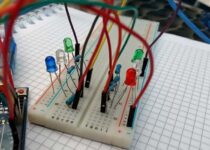Fun With Perf Boarding
Table of Contents
A Tutorial
Desoldering takes some practice and patience.
I will also give you the information you need to know to start practicing, the patience is up to you.

On this page, I will teach you how to remove solder and clean up the circuit board afterward.
I don’t claim to be an expert, but I have taken several classes throughout my 30+ years in the field of electronics and I’ve had a lot of practice, and patience too.
It’s kind of like an art but anyone can learn it and do it well with some practice, as long as you know the fundamentals.
The Fundamentals
Desoldering
This is pretty straight forward and simple. You want to remove as much solder as you can without destroying the components or the PCB. Too much heat can be an enemy so read on to see how to desolder safely and efficiently.
The Tools Of The Trade
There are several “tools” that you will need to desolder. Here is a list of some of the more important ones:


* A good soldering station or stand alone soldering iron. Something between 15 and 40 watts is best for desoldering.
* A small wire brush for cleaning the soldering iron tip.
* Solder. It used to be that a 60/40 Tin/Lead mix type of solder with rosin flux mixed in was the way to go. But due to concerns over atmospheric pollution and hazardous waste disposal, the electronics industry has been gradually shifting from rosin flux to water-soluble flux, which can be removed with de-ionized water and detergent, instead of hydrocarbon solvents. A smart choice if you are concerned about the environment. I personally prefer .025″ diameter solder. In my opinion, it’s just the right size for most projects.
* Solder-Wick or a solder sucker for desoldering.
* An acid brush for cleaning flux off the circuit board.

* Flux remover, whether it be for the old style flux or the water soluble type.
* A helping hands tool. This handy tool will help you by holding the PCB while you are holding the soldering iron in one hand and the desoldering tool in the other.

* A magnifying swing arm light. While this may not be necessary for all, for an old guy like me, it’s a must.

* A small fan is a good idea. Melting solder creates some nasty smoke that you really don’t want to breathe too much of.

* Eye protection is very important.
I’ve seen first hand what can happen when 400 degree solder flips up into the eye. A fellow student in college ended up in the hospital. It wasn’t pretty so use eye protection, please.
How To Desolder
There are basically three methods used to remove solder. The easiest is to use a solder removal tool which uses a soldering iron with a hole in the tip and a vacuum to suck the solder off the joint. These can be expensive and are usually used in electronic manufacturing facilities where they are used often.
Solder Wick

One much cheaper method is to use Solder Wick, a braided wire which is usually lightly coated with flux. The braid is laid on top of the joint to be desoldered and the soldering iron is set on top of the braid. When the solder melts it is drawn into the braid and removed from the joint.
Solder Sucker

Another inexpensive method is to use a manual solder sucker. This is a tube with a plunger and a small tip. I’m holding one at the top of the page.
The tip is held near the joint while the solder is melted. Once the solder is liquid, a button is pushed and the plunger releases causing the solder to be sucked into the tube.
Technique
A good method of desoldering involves both of the above methods. Most of the solder can be removed with the desoldering pump and any remaining can be removed with desoldering braid. Both of these methods are pretty inexpensive and the supplies can be found at Radio Shack.
Well that pretty much covers it. As I think of other tips I’ll add them. If you seasoned vets or even you newbie’s have any ideas you would like to share, please go to my contact page and send me a message.
One Last Thing
Soldering Disclaimer:
All of the information on this and any other page on this website is to be done at your own risk. Soldering irons are very hot and can cause severe burns. Melted solder can easily fly and get into places you don’t want it, so be careful. ALWAYS USE EYE PROTECTION. It’s just a good idea. If you get hurt or damage anything, IT’S NOT MY FAULT. Please use good judgment when performing these tasks. BE SAFE AND SMART. Thank you.


